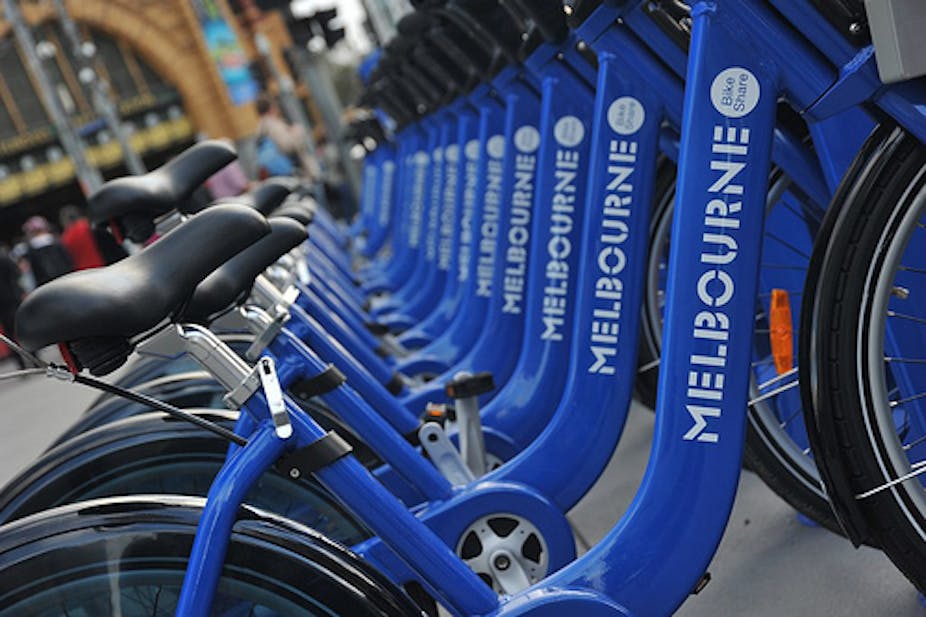Public bicycle hire schemes have the potential to generate the well-known health benefits that come with increased exercise.
But while Australia has bravely adopted such schemes, mandatory helmet laws continue to deter would-be cyclists.
Worldwide, more than 135 cities have developed bicycle share schemes to help reduce vehicle congestion and car parking problems, including Paris, London, Hangzhou, Montreal, Mexico City.
Melbourne and Brisbane started similar but smaller schemes last year to encourage bicycle use for short trips.
But unlike other schemes, Australia is the only country to mandate the use of helmets.
Benefits and risks of cycling
In this week’s British Medical Journal, researchers looked at the health risks and benefits of users of the “Bicing” public bicycle sharing scheme in Barcelona, Spain.
The researchers considered the 181,982 resident users of the bike share program and looked at deaths related to physical activity, road traffic incidents and exposure to air pollution.
Overall, they concluded that the additional physical activity from cycling instead of driving played a role in preventing 12 deaths.
They estimated the health benefits of riding a bicycle outweighed the risks of injury by a huge ratio of 77:1 – even if the bike was only ridden for comparatively short journeys.
The main reason for such a large benefit-to-risk ratio is the relatively low injury risk of cycling, despite minimal bicycle helmet use.
These findings are consistent with several other studies, including one published by the British Medical Association in 1992 that reported a cycling benefit-to-risk ratio of 20:1.
A more recent analysis from Holland found the health benefits of cycling added between three and 14 months to a person’s life.
This compares with the potential effect of increased inhaled air pollution (0.8 to 40 days lost) and the increase in traffic accidents (five to nine days lost).
Bicycle loan schemes are also interesting because they contribute a new source of data on cycling risk relative to exposure.
Cycling on the upright urban style of bicycle used in most of the schemes appears to be very safe indeed.
There have now been more than six million users of the “Boris bikes” in London. Distances cycled total more than 10 million kilometres, with few serious injuries. In the first three months the accident rate was estimated to be 0.002%.
There are similar observations from Dublin and other schemes.
Australia’s schemes
There are 50 bike stations and 600 bikes situated around the Melbourne CBD. Melbourne Bike Share is designed for short trips, which is why the first 30 minutes are free to subscribers (who pay $50 a year). Trips lasting longer than two hours can be expensive.
Brisbane now has 1,000 bikes at 101 CityCycle stations, with another 1000 bikes planned at a further 50 stations. For annual subscribers the first 30 minutes are free.
While figures on usage of the Brisbane and Melbourne schemes are hard to come by, the available information suggests the usage rate is very low, at about 10% of comparable programs in London or Dublin.
The poor uptake is likely due to a combination of poor cycling infrastructure and the requirement for users to wear helmets.
I’ve heard of potential users seeing the bikes lined up and going to have a look, only to turn away when they realise they needed a helmet and didn’t have one (and despite them being available in a nearby store in Melbourne for minimal cost).
Few people carry a helmet on the chance that they might want to borrow a bike for a quick trip to run an errand.
Only the Australian schemes require users to wear helmets. Mexico City (last year), and Israel (just last week) have repealed their adult helmet legislation, in part to make their bicycle share schemes viable.
Other factors, like population density and location of the bicycle stations play a role in usage of the scheme, but these things cannot be readily changed.
Given there is clear evidence from around the world of substantial health benefits and minimal risk from public bicycle share schemes, Australia should allow an exemption of the mandatory helmet legislation for such schemes.
Have you taken part in bike share schemes in Australia or abroad? Why/why not? Are mandatory helmet laws a deterrent? Leave your comments below.

